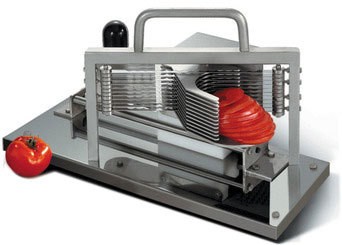Carving hard snow is kinda my thing, but let's leave that alone for a moment and consider skiing thick wet heavy snow; some call this snow Sierra cement. Just like a trowel will cut in the direction it is pointing due to being bent by the applied pressure, so will the ski. A flexible trowel in a vertical plane will be bent with the tip pointing left when the front of the trowel is pushed into the snow to the right. A ski tipped to the left and having it's forebody loaded will be bent so that the tip points more to the left. In the simplest most general terms, it's the well know "A properly tipped and pressured ski will take you where you want to go."
Skis have some give to them, so does most snow. Sierra cement is near one end of the spectrum, ice is near the other end.
There's a difference between a trowel and your ski. The trowel has no sidecut; a ski does. In order to create bend in the trowel, you have to create a steering angle; then the pressure differential will bend it as you push it (initially, at least) obliquely forward. The ski will bend simply by tipping (rotating it around it's longitudinal axis).
In order for the ski to turn and turn you, you do not need to load the tip -- it will turn simply by tipping the ski.
I don't know how much prep work you do in a kitchen but you do not use just the middle of a knife to carve. You can start near the tip of the knife and move it along the edge. A knife is designed to be moved along it's edge, not just from one section of it. I think there is a very close analogy to skiing where you start near the front of the ski and move along it, tip to tail.
I realize that right now it's the thing to keep your pressure only under foot, but these things change. Flavor of the day and all. Yet studying race technique and moving tip to tail hasn't changed.
We do appreciate your sharing what is the current approach with us, it's quite valuable. But like the weather in New England, wait a few minutes and it will change.
You seem to think I believe that you must stand in the center of the ski at all times. Nothing could be further from the truth. Most of the time in my skiing and certainly in my dynamic short turns and in my terrain skiing, I'm loading the tip of the ski in the initiation of the turn, moving to the center at the apex, and using the tail in the finish. But there's a purpose to where I'm trying to be on the ski. In high performance short turns, I'm trying to get on the front of the ski in the initiation to create a steering angle and allow the ski to start turning in a radius that's inside of the radius the sidecut of the ski would allow. I go to the center of the ski to get the maximum deflection of my center of mass across the hill, and I move to the tail in the finish for grip. In terrain skiing, I want the tip to bite high in the turn to impart a rotation to the ski, and I want the tail to catch in the finish to impart a rotation into the new turn. This preserves vertical distance down the hill.
Shifting weight from fore to aft is not a question of do it or not; it is a question of how much, and the answer ranges from none to lots and depends on intent and conditions.
Absolutely.

